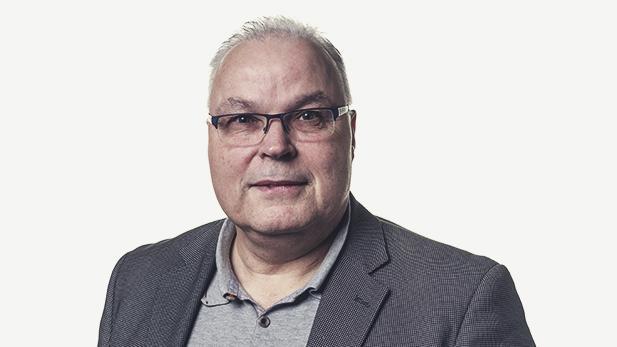Danish design classics had a new lifespan and theory was rewritten
Interview with Professor John Christiansen
Can you remember when and where you were when you got the initial idea for this research project?
"I was sitting in my office on Solbjerg Plads. Ideas typically appear based on a context and this time the context was my colleague Associate Professor Claus Varnes stopping by with some observations that he’d made about some material produced by a group of students. He was their tutor and had assisted them in a collaboration with the design furniture manufacturer Fritz Hansen. The students had immersed themselves in their topic and done a really good job. Their preliminary data indicated that some of the products, including the Egg designed by Arne Jacobsen, challenged standard assumptions about product life cycle.
The question was how we could use these observations to carry out an exciting interpretation of the data. I thought that they could be interpreted in a certain way and we agreed that it was really interesting. Consequently we asked the students to continue with their data collection to see if this exciting pattern would continue. Our first assumption, which proved to be correct, led us to this project. Thus you could say that this is an example of why teaching-based research shouldn’t be underestimated."
What inspired you to do this specific research?
"Initially it was the data that inspired me. You could compare it to a researcher examining a cell sample under a microscope who discovers that the cells are behaving contrary to expectation. That’s exactly what the initial data showed, an abnormal pattern compared to the conventional way of portraying product life cycle. The normal pattern is a ski slope that starts low, grows, reaches a peak and plateaus after a certain amount of time before finally being removed from the market. The students discovered that the sale of the Egg appeared to follow a normal development curve and then simmered at a very low level only to bubble up again, fall again and then grow to reach its initial highest point again. Our data cover 50 years, which is interesting when you start digging into it. We began to think we’d seen a similar pattern for some products where companies had succeeded in re-launching them as ‘retro’ items. A well-known example is Rayban sunglasses, with models launched in the 1960s still selling."
What events within society that the research affects gave rise to the research and opened doors for the project?
"First, there’s the curve we derived from the Fritz Hansen data and the fact that other products also experience a renaissance sometimes. How then can we explain that consumers have been attracted to this product to varying degrees for 50 years? To answer this question we used sociological theories to examine why a product is seen as valuable for such a long time after it’s been launched. Our conclusion is that the reason is partly due to external factors and partly what the company does with the product. We call it “framing” the product – what does the company do to make consumers aware of the product? With the Egg, it’s clear that the consumers’ impression of its value increases greatly over time. For the Egg, our assessment shows that a deep dive in product sales is due to a combination of external factors and the company’s own efforts. In this case, management simply failed to pay attention to the product. Verner Panton was appointed to take over Arne Jacobsen’s roll, which is why there was a slowdown in products designed by Arne Jacobsen. In this case it could well be that they could have earned more money by continuing to draw attention to Arne Jacobsen products."
What conclusions can be drawn from your research?
The conclusion is that companies don’t need to assume that the accepted curve for any product cycle is correct. It’s possible to process and establish products in a variety of ways even though they may encounter bad luck on the market. Textbooks have traditionally presented the idea that the product cycle looks like this: Initially the item is purchased especially by curious consumers, then by ordinary consumers and finally by stragglers. Thus the product becomes established and at some point new products are introduced that challenge the established ones. Perhaps they offer better quality, performance or design. This challenges the incumbent product, which loses the battle and is then phased out. At this point the company must be ready to replace the product. Numerous people have pointed out that the curve may vary slightly; technical products, for example can require being launched more than once before consumers accept them. This was the case with MP3 players, which were chiefly purchased by young people initially until Apple introduced the iPod, which truly established the product with consumers. But our research shows that the sales curve can also look different for other products, and that it can be tweaked. We’ve also had the pleasure of seeing some of our international colleagues revise their textbooks on product life cycle because of our research. Every product has its own – partially manipulatable – curve, but it’s ill advised to generalise across industries and products. Ideas maintaining that products follow completely identical trends in specific industries must be treated with caution.
Who does the research affect?
Companies, by an awareness of the potential for fluctuation in product life cycle and marketers, through the message that framing and the history of a product can make a big difference. It also applies to product developers because if different variations can be incorporated in a product then it may have a longer life. People who study companies can also benefit from our research. For example, investors can be aware that a product portfolio in some companies can have a longer life than previously expected. The implication is that a product portfolio can be managed very differently. Fritz Hansen, for instance experienced very big crises several times. At one point the existing management bought the company from the shareholders. External consultants were consequently brought in to review the product portfolio and one of their recommendations was to close down production of the Egg because so few of them were sold. In the eyes of the consultants stopping sale of the product made sense. Fortunately, management did not heed their advice. And this is perhaps a good example to keep in mind when looking at the life cycle of a product.
How are the findings relevant to society?
In that way our research indicates that products are not just something launched only to be thrown out based on a fixed pattern. Products can remain in the minds of consumers for a long time if they are framed correctly. Fritz Hansen discovered, for example that many people wanted to buy the Egg chair but couldn’t afford it. As a result they made another version upholstered with fabric instead of expensive leather. This shows that adjusting existing products slightly should be considered before simply producing something new. And if you can expand the market for your product in this way, it can benefit the company greatly. Another example is low-entry products, which may look and feel like the expensive product, but are cheaper to produce for a variety of reasons. 
Photo: Ditte Isager, fritzhansen.com
What is the strongest example of that research that has made a positive difference for the companies or organisations involved?
The management at Fritz Hansen has repeatedly said that our research gave them something to think about, which is probably the closest you can get to praise from a company. It has given them a reason to reflect on how they manage their existing product portfolio. So presenting our interpretations has been a great experience with the company. They’ve realised they can go back and avoid making the same mistake as well as do something to reintroduce products. It has also had the effect that we can provide students with the opportunity to gain more knowledge about this area. We’re all familiar with examples of re-launch of old products, but published research provides a different value and we can see that our article gets quoted regularly.
What perspectives does the research have – what new issues relevant to society has it raised that have been taken up or ought to be taken up by you and other researchers since publication?
One issue at any rate is how to remain mentally open with regard to existing products. Many people associate innovation with inventing something new and that in itself is problematic because a great deal of innovation involves, in reality, taking ideas from one area and moving them to another. In this case innovation refers to maintaining products on the designer furniture market. But it would also be innovative if the same methods were tried with other products. Of course not every product can live forever and it’s also worth considering whether all products can sell in the same way as the Egg. There will always be a market for unique high-end design that appeals to the consumer. But there are also some iconic designs that die out, for example the 2CV. It was a unique product but it didn’t have the necessary safety precautions and lacked comfort. If a new version, however, was made that resembled the old one that was safer and a little better insulated, it could be a big success. With regard to additional research we would really like to gain access to data from more companies for comparison. It’s incredibly difficult to gain access to data from companies that go back more than five years. It was unique that we could get data from Fritz Hansen from 50 years ago. Most companies update their accounting system every five years and the old data is thrown in the trash. In that way companies have an incredibly short-term memory, which may also contribute to the fact that you don’t see products with different life cycles.
